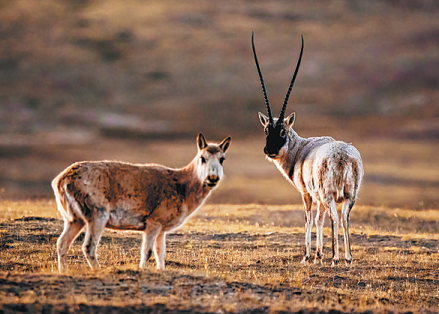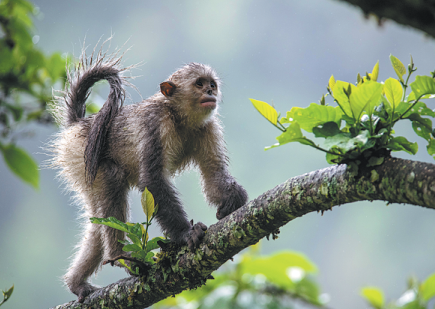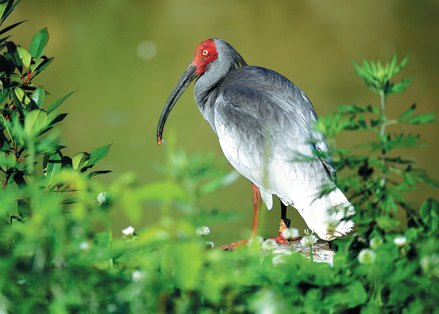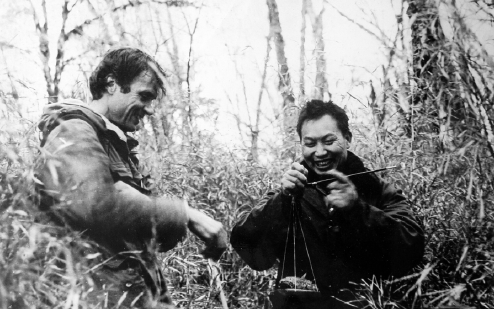FOREIGN EXPERTS HAIL NATION'S BIODIVERSITY HEROES
Series of efforts to safeguard species welcomed
As Terry Townshend sat in a secluded bamboo grove at the Research Base of Giant Panda Breeding in Chengdu, Sichuan province, he began to recall the people he had met during his trip. "For me, these people are heroes, and a lot of them are unsung heroes," he said.
It was the last day of a trip to Sichuan and Shaanxi provinces for wildlife conservationist Townshend and Alice C. Hughes, associate professor at the Chinese Academy of Sciences' Center for Integrative Conservation.
Invited by Xinhua News Agency's China Chat Show, the two experts from the United Kingdom traveled to numerous cities, villages and nature reserves in the two provinces, visiting and interviewing conservationists and biodiversity specialists.
"Most of their stories don't get told, so we should celebrate the few that do," Townshend said.
Meanwhile, Hu Jinchu, a retired professor, looked through his photo album and recalled the day 47 years ago when he first set foot in rural Sichuan to investigate wild giant pandas.
The 92-year-old, known affectionately as the "panda papa", is China's pioneer of giant panda ecological and biological research. "We ourselves didn't even know how many giant pandas there were in the country," he said.
There used to be a lack of information in China about the pandas, whose name translates as "giant bear cat", which have become national treasures.
In 1972, when United States President Richard Nixon boarded his flight home from Shanghai, he returned to Washington with not only memories of China, but also a pledge from Chinese Premier Zhou Enlai that China would give a pair of giant pandas to the US.
A survey on rare animals was later requested in China, particularly on giant pandas found in Sichuan, Gansu and Shaanxi provinces.
In 1974, Hu was sent to Sichuan and was appointed team leader of a survey group of some 30 members to investigate the rare species discovered in the province. During the investigation, he invented the comparative analysis procedure known as the "Hu method." The process uses giant panda feces to determine the creatures' age, population and range of activities, as well as other vital information.
In the 1980s, the China Conservation and Research Center for the Giant Panda was established in Wolong, Sichuan, in cooperation with the World Wildlife Fund, now the World Wide Fund for Nature, or WWF.
George Schaller, a prominent US wildlife researcher and zoologist, named by Time magazine as one of the "Heroes of the Environment "in 2007, was among the foreign experts stationed at the center.
Schaller and Hu worked together for many years, collecting huge amounts of data on wild pandas, laying a solid foundation for protecting the animals in China.
"Hu contributed greatly to China's huge achievements in giant panda conservation," Schaller said.
Hu shared his experience with Hughes at his home in Nanchong city, Sichuan. "Research conditions were rather tough at that time. All we had were our legs and a pair of binoculars," Hu said.
In 1980, after hearing that a giant panda had died in the forest, Hu rushed to the scene, where he performed an autopsy on the highly decomposed carcass, from which more than 2,000 roundworms were removed. His work resulted in the first detailed record of roundworm infection in the history of giant panda research.
Hughes said: "It was a pretty unhealthy panda. None of the villagers would go anywhere near it, saying it smelled too bad."
After years of collaborative research with WWF, in 1985, Hu and his team completed the world's first comprehensive study on the ecology and habits of the giant panda, titled "The Giant Panda of Wolong."
Hu's life has been full of unforgettable experiences and achievements, but at age 92, he said his greatest regret is that he will not be able to continue his work forever. "I haven't done enough," he added.
Hughes and Hu exchanged stories and spent time going through the panda expert's photo album.
The image that caught Hughes' eye was one from Hu's birthday party celebrations with his students. Hughes spotted a few familiar faces she knew who are now among the leading academicians in China.
Crested ibis efforts
The crested ibis, one of the oldest avian species in the world, once flourished in China, the Korean Peninsula, Japan and Russia. It is believed that these birds have existed for more than 60 million years.
However, the widespread use of pesticides and fertilizers, hunting, and habitat loss due to deforestation brought this species, known as the "oriental gem", to the brink of extinction.
In 1963, the crested ibis was regionally extinct in Russia. In 1975, the species vanished from the Korean Peninsula, and in 1981, Japanese experts caught the last five wild crested ibises in the country and kept them in captivity. Japan's last crested ibis born in the wild died in 2003.
By the 1970s, the birds were nearly wiped out in the wild and were included on the International Union for Conservation of Nature's Red List of threatened species.
In 1978, Liu Yinzeng, then a researcher at the Chinese Academy of Sciences, led a team to search for the birds throughout China.
"At that time, I had prepared my paper concluding that the crested ibis had become extinct," Liu said.
After three years of relentless search efforts that took Liu and his team on a 50,000-kilometer journey through 14 provinces, the remaining group of the endangered species, comprising just seven birds, was finally found in Yangxian county, Shaanxi, in May 1981.
Liu was worried whether such a tiny population could survive, but the team came up with solutions. "Our breeding program followed two approaches: one was natural breeding in the wild, and the other was artificial breeding," Liu said.
In addition to breeding, protection measures were implemented in Yangxian, including establishing observatories, rescue centers and a national nature reserve; prohibiting mining, hunting and logging; ending the use of fertilizers and pesticides; and guiding farmers to keep natural wetlands for the birds to forage.
The government, experts and local residents have made considerable efforts to make Yangxian a better place for this once-endangered species.
After 40 years of hard work and determination, the number of wild crested ibises in the world has risen from seven to 7,000, with more than 3,000 making Yangxian their home. The habitat area for the birds has expanded from less than 5 square km at the time of discovery to 15,000 sq km.
Townshend learned about Liu's inspiring experience after spending an afternoon with him in Yangxian, and believes that this remarkable story is worth sharing.
"The overall picture of the biodiversity world is quite grim. What this example shows is that we can make a difference. It's not all lost," Townshend said.
He told Liu, now 85, "Maybe in a previous life you were a crested ibis!"
Stewards of nature
For the past 40 years, locals in Yangxian have worked hard to protect the crested ibis while also improving the quality of life for the species.
Hughes said during the China Chat Show group discussion on the last day of the trip: "Local people are the stewards. They are the people who are looking after biodiversity. So, it has to be economically viable for them."
In the 1980s, to protect the crested ibis, the Yangxian government restricted the use of pesticides by farmers. Many of them questioned this regulation, asking how they could kill insects without using pesticides.
At the time, no one thought that the regulation presented farmers with an opportunity.
The farmers switched to using trap lights to kill insects, leading to the production of organic agricultural products. Yangxian now has a crested ibis organic products brand valued at more than 9.3 billion yuan (about $1.44 billion).
Hua Ying is one of the Yangxian residents to benefit from protection of the ibis.
In 2001, two ibises nested less than 10 meters from Hua's house. "Every morning, when the ibises tweet, we know that it's time to send the kids to school. When I do farm work in the field, the birds are often next to me. Gradually, my affection for the ibis grew," he said.
A few years ago, Hua transformed his front yard into a sanctuary for crested ibises, and he now runs a homestay for bird enthusiasts and photographers.
Townshend said: "He has created a pond with food for the crested ibises, and he has trees close by where they make their nests. People can stay with him and have amazing views of the birds."
Apart from sleeping well, tourists also eat well, enjoying products such as locally made honey, black rice tea and porridge.
Townshend said he admired Hua's accomplishments, adding that they are a great example of how a community can benefit sustainably from policies and practices that benefit the crested ibis and help compensate the community for its role in safeguarding the environment.
"It's something that I think China should be proud of and that more people should hear about," he said.
Hughes said during the China Chat Show discussion that there are many similar untold stories across China in areas where rural communities care about biodiversity.
"There are various community conservation programs nationwide that have provided new hope for various species," she added.
The bird watcher
Having spent 10 years living and working in Beijing as a bird enthusiast, Townshend has always enjoyed exploring the city with his camera and binoculars.
When he started watching birds in the Chinese capital, he often found people trapping them, predominantly for the cage bird trade. Townshend said law enforcement authorities were not interested in responding to such complaints.
"You would call them, and it was almost as if they were saying: 'You're calling me about birds? I have so many more important things to do'," he said. "That was the general attitude, but now it's very different."
Townshend still occasionally finds people trapping birds, but he said the reaction of law enforcement authorities has changed.
He now has local police on his WeChat account, and if he finds anyone trapping birds, he can immediately send the authorities the location and a picture of the scene, and they respond quickly.
"Normally, within an hour, they will be there, and that is a huge change from 10 years ago," he said.
Townshend launched a project to track some of the capital's most iconic birds, including the Beijing swift, a migratory species that has been in the city since the 1400s.
He smiled as he shared the fascinating findings from his project. "The Beijing swift flies all the way to South Africa in the northern winter and then comes back to Beijing," he said.
"Even more incredible is that the birds almost certainly don't land during the nine months of traveling. They're eating, drinking and sleeping in the air," he said.
This incredible story inspired schools in Beijing to put up nest boxes on their campuses to provide homes for the swifts. Students have written to construction companies, asking them to make new buildings more "friendly" for the birds.
In April, Townshend was invited to share his experience at a meeting with the Beijing municipal government called to discuss managing renovations to many old buildings in the city, which are vital nesting sites for the swifts.
He said the ideal solution would be for renovations to be carried out while the birds were away from Beijing, or if they had to be done while the swifts were in the city, ways should be considered to enable the birds to access their nests.
Townshend thinks such conservation efforts would have been unlikely five or 10 years ago. "It's just a small example, but it shows that there's a general greater awareness and consideration of biodiversity," he said.
For him, the biggest eye-opener during the trip was the dedication of so many individuals to protecting and restoring nature.
"The other thing that came through strongly was that when people work together and put in the right resources, we can achieve amazing things. Those stories can inspire people not only within China but around the world, and give them hope," he said.
Xinhua's China Chat Studio exclusively for China Daily.




